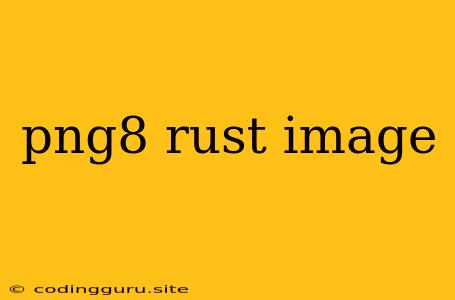Working with PNG8 Images in Rust
Rust is a powerful and efficient programming language, and its image processing capabilities are no exception. If you need to work with PNG8 images in your Rust project, this guide will walk you through the process and provide you with the necessary information.
What is PNG8?
PNG8 is a variation of the PNG image format that uses a palette to reduce the number of colors in an image. This results in smaller file sizes, making it ideal for web graphics and other applications where bandwidth is a concern.
Why Use PNG8 in Rust?
Here are a few reasons why you might choose to work with PNG8 images in your Rust applications:
- Smaller file sizes: PNG8 images can be significantly smaller than their 24-bit or 32-bit PNG counterparts, especially for images with a limited number of colors.
- Faster loading times: Smaller file sizes translate to faster loading times, which can be important for web applications and other applications where performance matters.
- Suitable for web graphics: PNG8 is a common format for web graphics, especially icons and sprites, due to its support for transparency and its ability to achieve a balance between image quality and file size.
How to Work with PNG8 Images in Rust
The image crate is a popular choice for image processing in Rust. It provides a convenient API for loading, saving, and manipulating images, including PNG8 images.
Loading a PNG8 Image
use image::open;
fn main() {
let image = open("path/to/image.png").unwrap();
// Check if the image is a PNG8 image
if image.color().is_palette() {
println!("Image is a PNG8 image");
} else {
println!("Image is not a PNG8 image");
}
}
Saving a PNG8 Image
use image::{ImageBuffer, Rgb};
use image::png::PNGEncoder;
use std::io::File;
fn main() {
// Create a new image buffer
let mut image = ImageBuffer::new(100, 100);
// Set the pixel color for the image
for (x, y, pixel) in image.enumerate_pixels_mut() {
*pixel = Rgb([255, 0, 0]);
}
// Save the image as a PNG8 image
let output = File::create("output.png").unwrap();
let encoder = PNGEncoder::new(output);
encoder.encode(&image, image.width(), image.height(), image.color()).unwrap();
}
Converting an Image to PNG8
The image crate can also be used to convert an image to a PNG8 image. The quantize method can be used to reduce the number of colors in an image, and then the image can be saved as a PNG8 image.
use image::{open, DynamicImage};
use image::png::PNGEncoder;
use std::io::File;
fn main() {
// Load the image
let image = open("path/to/image.png").unwrap();
// Quantize the image to a palette of 256 colors
let image = image.quantize(256);
// Save the quantized image as a PNG8 image
let output = File::create("output.png").unwrap();
let encoder = PNGEncoder::new(output);
encoder.encode(&image, image.width(), image.height(), image.color()).unwrap();
}
Important Considerations:
- Color palette: When converting an image to PNG8, you need to choose an appropriate color palette to minimize the loss of image quality. The
imagecrate provides methods for generating color palettes based on different algorithms. - File size: The file size of a PNG8 image will depend on the number of colors in the palette. A smaller palette will result in a smaller file size, but it may also lead to a greater loss of image quality.
- Transparency: PNG8 supports transparency, but it is important to note that the transparency level is limited to a single value for the entire image.
Beyond Basic Manipulation
The image crate offers a variety of functionalities for working with PNG8 images:
- Image filtering: You can apply various filters to PNG8 images, such as blurring, sharpening, and edge detection.
- Image resizing: You can resize PNG8 images while preserving their quality.
- Image cropping: You can crop PNG8 images to extract specific regions.
- Image rotation: You can rotate PNG8 images by any angle.
Examples
Here are a few examples of how you can use the image crate to work with PNG8 images in Rust:
- Generating a PNG8 image with a gradient:
use image::{ImageBuffer, Rgb};
use image::png::PNGEncoder;
use std::io::File;
fn main() {
// Create a new image buffer
let mut image = ImageBuffer::new(100, 100);
// Set the pixel color for the image
for (x, y, pixel) in image.enumerate_pixels_mut() {
*pixel = Rgb([x as u8, y as u8, 0]);
}
// Save the image as a PNG8 image
let output = File::create("output.png").unwrap();
let encoder = PNGEncoder::new(output);
encoder.encode(&image, image.width(), image.height(), image.color()).unwrap();
}
- Loading a PNG8 image and displaying its palette:
use image::open;
fn main() {
let image = open("path/to/image.png").unwrap();
// Get the image's palette
let palette = image.palette().unwrap();
// Print the palette
println!("Palette:");
for color in palette {
println!(" RGB: ({}, {}, {})", color[0], color[1], color[2]);
}
}
Conclusion
The image crate is a powerful and versatile tool for working with PNG8 images in Rust. Whether you need to load, save, convert, or manipulate PNG8 images, the image crate provides the necessary functionalities to get the job done. By utilizing PNG8, you can optimize your images for performance, efficiency, and web-friendliness in your Rust applications.
